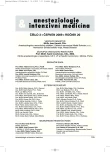Dynamic parameters of preload in pressure support ventilation
Authors:
Suk Pavel; Zvoníček Václav; Pavlík Martin; Štětka Pavel; Šrámek Vladimír
Authors‘ workplace:
Anesteziologicko-resuscitační klinika, Fakultní nemocnice u sv. Anny a Masarykova univerzita, Brno
Published in:
Anest. intenziv. Med., 20, 2009, č. 3, s. 137-142
Category:
Intensive Care Medicine - Original Paper
Overview
Objective:
To prove the reliability of pulse pressure variation (PPV) and stroke volume variation (SVV) in prediction of fluid responsiveness in patients on pressure support ventilation (PSV) and to assess the relationship between respiratory changes in filling pressures and pleural pressure.
Design:
Prospective clinical trial.
Setting:
University hospital multidisciplinary ICU.
Methods:
Patients with sinus rhythm on PSV in whom cardiac index (CI) was measured by thermodilution. Arterial, central venous (CVP) and pulmonary artery occlusion pressure (PAOP) were recorded and PPV, SVV, inspiratory drop in CVP (∆CVP) and PAOP (∆PAOP) calculated. Oesophageal pressure (Pes) was measured by balloon-tipped catheter. Fluid challenge: HES 500ml during 30 min. Data presented as median (interquartile range).
Results:
Total 17 patients, 2 excluded due to new atrial fibrillation. Fluid challenge tended to increase CI from 4.6 (3.4–5.6) to 4.9 (3.6–6.1) l . min-1 . m-2 (p = 0.098). Positive response (increase in CI > 10%) was recorded in 6 cases. PPV did not differ between responders 6.7 (2.7–13.8) % and non-responders 6.3 (4.3–9.0) % to fluid challenge (p = 0.851); for SVV 11.3 (6.1–17.4) % versus 9.1 (5.5–12.8) % (p = 0.64). ∆Pes was 17 (7–19) cm H2O. Correlation ∆PAOP and ∆Pes: r2 = 0.69; p < 0.001; ∆Pes and ∆CVP: r2 = 0.53; p < 0.001.
Conclusion:
PPV and SVV failed in prediction of fluid responsiveness in patients on PSV. Changes of PAOP and less of CVP can be used for estimation of pleural pressure changes.
Keywords:
heart-lung interactions – pressure support ventilation – pulse pressure variation – stroke volume variation – cardiac output – pulmonary artery occlusion pressure
Sources
1. Michard, F., Teboul, J. L. Using heart–lung interactions to assess fluid responsiveness during mechanical ventilation. Crit. Care, 2000, 4, p. 282–289.
2. Osman, D., Ridel, C., Ray, P., Monnet, X., Anguel, N., Richard, C., Teboul, J. L. Cardiac filling pressures are not appropriate to predict hemodynamic response to volume challenge. Crit. Care Med., 2007, 35, p. 64–68.
3. Coudray, A., Romand, J. A., Treggiari, M., Bendjelid, K. Fluid responsiveness in spontaneously breathing patients: A review of indexes used in intensive care. Crit. Care Med., 2005, 33, p. 2757–2762.
4. Magder, S. A., Georgiadis, G., Cheong, T. Respiratory variations in right atrial pressure predict response to fluid challenge. J. Crit. Care, 1992, 7, p. 76–85.
5. Michard, F., Boussat, S., Chemla, D., Anguel, N., Mercat, A., Lecarpentier, Y., Richard, C., Pinsky, M. R., Teboul, J. L. Relation between respiratory changes in arterial pulse pressure and fluid responsiveness in septic patients with acute circulatory failure. Am. J. Respir. Crit. Care Med., 2000, 162, p. 134–138.
6. Berkenstadt, H., Margalit, N., Hadani, M., Friedman, Z., Segal, E., Villa, Y., Perel, A. Stroke volume variation as a predictor of fluid responsiveness in patients undergoing brain surgery. Anesth. Analg., 2001, 92, p. 984–989.
7. Baydur, A., Behrakis, P. K., Zin, W. A., Jaeger, M., Milic-Emili, J. A simple method for assessing the validity of the esophageal balloon technique. Am. Rev. Respir. Dis., 1982, 126, p. 788–791.
8. Perner, A., Faber, T. Stroke volume variation does not predict fluid responsiveness in patients with septic shock on pressure support ventilation. Acta Anaesthesiol. Scand., 2006, 50, p. 1068–1073.
9. Heenen, S., DeBacker, D., Vincent, J. L. How can the response to volume expansion in patients with spontaneous respiratory movements be predicted? Crit. Care, 2006, 10, p. R102.
10. Soubrier, S., Saulnier, F., Hubert, H., Delour, P., Lenci, H., Onimus, T., Nseir, S., Durocher, A. Can dynamic indicators help the prediction of fluid responsiveness in spontaneously breathing critically ill patients? Intensive Care Med., 2007, 33, p. 1117–1124.
11. Reuter, D. A., Bayerlein, J., Goepfert, M. S., Weis, F. C., Kilger, E., Lamm, P., Goetz, A. E. Influence of tidal volume on left ventricular stroke volume variation measured by pulse contour analysis in mechanically ventilated patients. Intensive Care Med., 2003, 29, p. 476–480.
12. Bellemare, P., Goldberg, P., Magder, S. A. Variations in pulmonary artery occlusion pressure to estimate changes in pleural pressure. Intensive Care Med., 2007, 33, p. 2004–2008.
13. Hyung, K. K., Pinsky, M. R. Effect of tidal volume, sampling duration, and cardiac contractility on pulse pressure and stroke volume variation during positive-pressure ventilation. Crit. Care Med., 2008, 36, p. 2858–2862.
14. Matejovic, M., Krouzecky, A., Rokyta, R. Jr., Novak, I. Fluid challenge in patients at risk for fluid loading-induced pulmonary edema. Acta Anaesthesiol Scand., 2004, 48, p. 69–73.
15. Monnet, X., Rienzo, M., Osman, D., Anguel, N., Richard, C., Pinsky, M. R., Teboul, J. L. Passive leg raising predicts fluid responsiveness in the critically ill. Crit. Care Med., 2006, 34, p. 1402–1407.
Labels
Anaesthesiology, Resuscitation and Inten Intensive Care MedicineArticle was published in
Anaesthesiology and Intensive Care Medicine

2009 Issue 3
Most read in this issue
- Analgosedation in Intensive Care Units (ICU) in the Czech Republic – the results of questionnaire study
- Delirium during the postoperative period and in the intensive medicine
- Catheter-related blood stream infections
- Dynamic parameters of preload in pressure support ventilation
